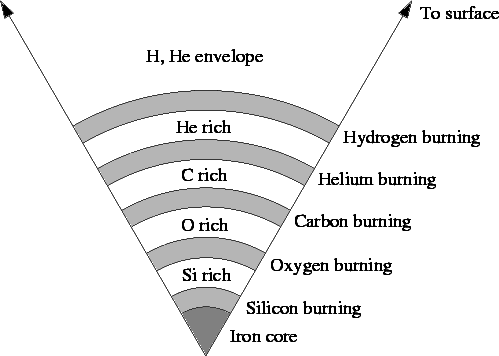Late Stage Nuclear Burning in High Mass Stars
If the mass of a star is > ~ 8 Msun, the temperature
and density of the C/O core can rise to levels where carbon-burning
can
occur:
 which creates a central "ashpile" of oxygen and other heavy
metals. As this ashpile contracts, its temperature and density can rise,
igniting oxygen burning:
which creates a central "ashpile" of oxygen and other heavy
metals. As this ashpile contracts, its temperature and density can rise,
igniting oxygen burning:
 This oxygen ashpile can contract, and, well, you get the
idea. The star's core takes on an onion-skin structure
of nuclear burning:
This oxygen ashpile can contract, and, well, you get the
idea. The star's core takes on an onion-skin structure
of nuclear burning:

Less and less energy is produced per nuclear reaction
in the nucleosynthesis of these high mass elements. So each burning phase
lasts a shorter and shorter amount of time:
For a 15 Msun star:
|
Reaction
|
Timescale
|
|
Hydrogen burning
|
10 million years
|
|
Helium burning
|
1 million years
|
|
Carbon burning
|
300 years
|
|
Oxygen burning
|
200 days
|
|
Silicon burning
|
2 days
|
Silicon burning makes iron, and iron won't burn to make
more massive elements. It is the most stable nucleus. No more nuclear energy
is available to the star. Now what?



